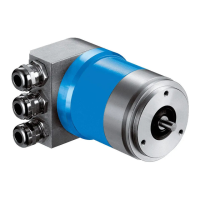S
stem Confi
uration
Dec 2021
ATM60 / ATM90 / KHK53 41
8.4 Configuration
In the 'Wait_Config' state, the configuration telegram defines the format for the cyclical data traf-
fic (I/O data for every network subscriber).
All formats supported by the slave are defined in the GSD file with the keyword "Module". Using
the configuration tool, at least one of these modules must be selected for projecting the device
to be integrated.
According to the encoder profile, the encoder supports the data consistency with a max. of one
(1) module.
The general
ID format (specified with '1' byte) is used.
The modules are defined by number and content of the ID formats.
One
(1) ID format (byte) per module is specified in the GSD file.
Specification of the general ID format (byte):
Bit 7 Consistency { 0: No, 1: Yes }
Bit 6 Format data length { 0: byte, 1: word }
Bit 5 | 4 Mode { 1|1: Input+Output, 1|0: Output, 0|1: Input, 0|0: Specific Format }
Bit 3...0 Code length { 0000 = 1, 0001 = 2, ...1111 = 16 }
The specification only defines the data length (in word and bytes) produced or consumed by a
network subscriber, however not
the content of the input/output data. Definition and allocation of
the data assemblies (data components) for the individual modules are based on the application,
and are defined by a profile or by the manufacturer. -- see Data Assemblies (6.4).
Number and content of the transmitted ID formats, and the length of the INPUT/OUTPUT data
resulting from the content, are checked by the slave and acknowledged as positive or negative
responses. The next state within the 'State Machine' is reached only when a valid telegram is
recognised.
The following modules can be selected via the ID format in the Chk_Cfg telegram.
Service DDLM_Chk_Cfg
Module Assembly ID format Value
(hex)
IN_04 1 Encoder Class 1 -- 2 word input D1
IO_04 2 Encoder Class 2 -- 2 word input/2 word output F1
(Default)
IN_06
(c1)
3 Manufacturer-specific -- 3 word input D2
IO_06
(c1)
4 Manufacturer-specific -- 3 word input/3 word output F2
IN_08
(c2)
5 Manufacturer-specific-- 4 word input D3
IO_08
(c2)
6 Manufacturer-specific-- 4 word input/4 word output F3
(c1)
This function is not supported by the ATM60-P,
ATM90-P encoders.
(c2)
This function is not supported by the KHK53-P encoder.
The composition of the input/output modules is described on the following pages.

